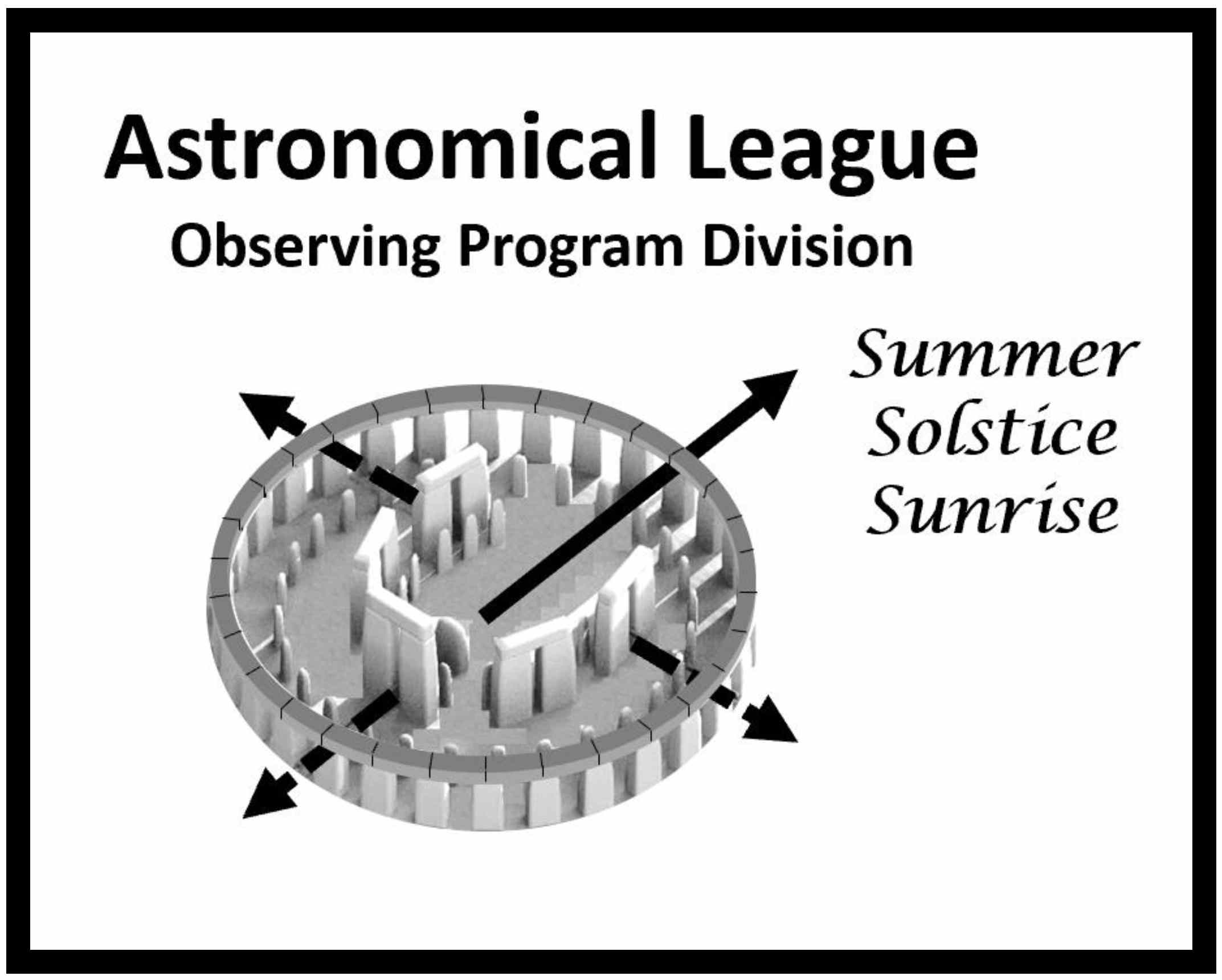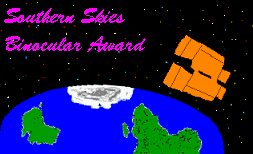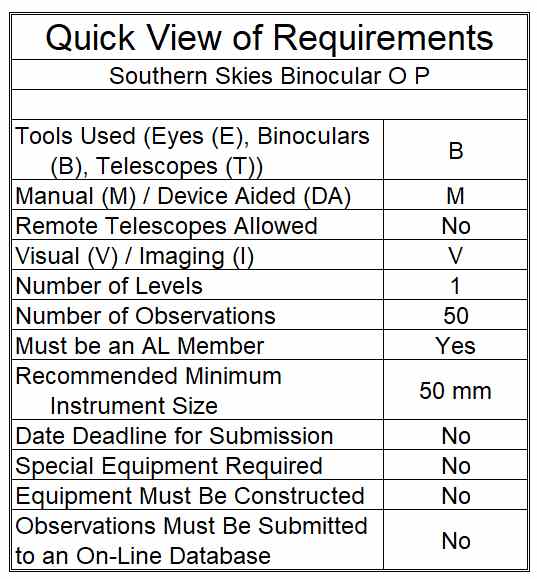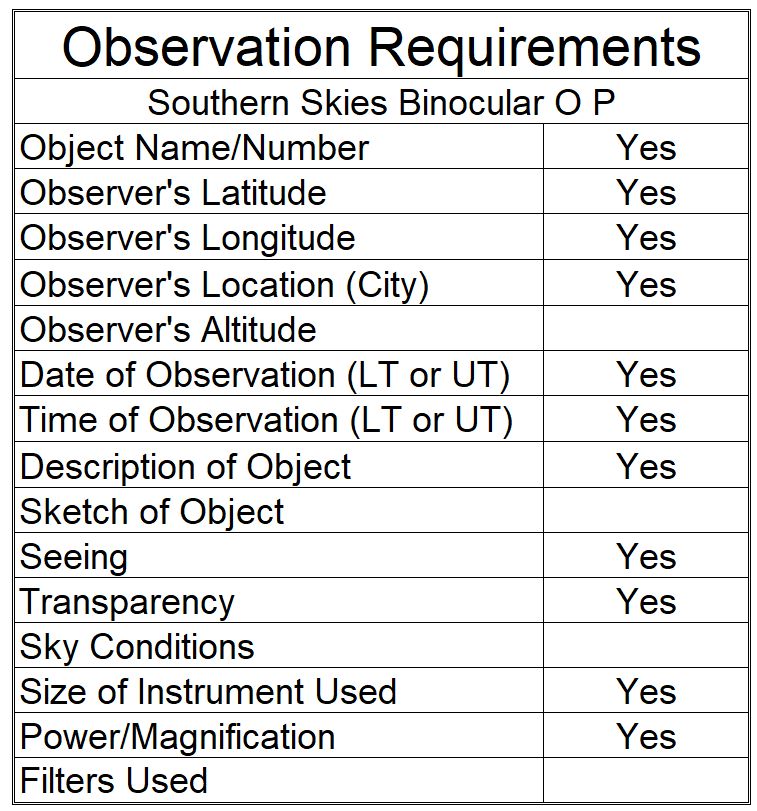Southern Sky Binocular Observing Program Coordinator:Cindy La Russa |
  |
Introduction
| Welcome to the Astronomical League’s Southern Skies Binocular Observing Program. The first question that comes to mind is “If we all live in the Northern Hemisphere, why do we need a program whose list of objects can only be seen from the Southern Hemisphere?”. Well, probably the best answer is that this was something that I just had to do. The Binocular Messier Observing Program in tandem with the Deep Sky Binocular Observing Program presents a complete list of binocular objects that can be reasonably observed in the Northern Hemisphere. Likewise, the Southern Skies Binocular Observing Program presents a complete list of binocular objects that can be reasonably observed from the Southern Hemisphere. Together, this trilogy of binocular programs gives one an all-sky survey of deep sky objects that are within range of small aperture binoculars.
But if you happen to be going to the Southern Hemisphere on business, why not drop a pair of binoculars in your suitcase and do some observing while you are there? Or if you are going to the Southern Hemisphere on vacation, again, take along your binoculars and sneak in some observing. If you are in the Southern Hemisphere for a Total Solar Eclipse, this would be an ideal time to do some deep sky observing with binoculars as well as observe the eclipse. If you are going to the Southern Hemisphere on an observing trip, what better way to travel light and observe the wonders of the southern skies, while getting credit for your observations by picking up an Astronomical League Southern Skies Binocular Observing Program certificate? Finally, if you are traveling to the Southern Hemisphere for the sole purpose of observing, but with a telescope, why not take this list along as a guide to the best showpiece objects to observe, without wasting the limited time you have there on commonplace objects? |
 |
Over two hundred Southern Hemisphere deep sky objects were surveyed to come up with this list of seventy-three objects readily observable with 7×50 binoculars. All objects on this list had to be below minus forty degrees declination to qualify as a Southern Hemisphere object. To qualify for the Astronomical League’s Southern Skies Binocular Observing Program Certificate, you need only observe 50 of the 73 objects on this list. You may choose which 50 objects you want to submit for certification. The reason for this is that many of us will only have limited access to the Southern Hemisphere, maybe only one or two visits in a lifetime, while, at the same time, we may not have control over the best time of the year to observe in the Southern Hemisphere. An experienced binocular observer with two good nights of observing any time during the year should be able to acquire this certificate.
Definition of Binoculars Allowed for Observations
The Astronomical League defines a binocular telescope as an observing device with two optical tubes and two eyepieces, where the eyepieces can be replaced with eyepieces of different focal lengths. “Bino-Viewers” have a single optical tube, but two eyepieces. “Bino-Viewers” and Binocular Telescopes may be used in any Observing Programs that are telescope-based. They may not be used in binocular programs.
Observing devices with two optical tubes and two eyepieces, where you cannot change the eyepieces, are binoculars. Binoculars may be used in any Observing Program requiring telescopes or binoculars. Most binoculars do not have sufficient magnification to replace telescopes.
Requirements and Rules
This certification is available to members of the Astronomical League, either through their local astronomical society or as members at large. If you are not a member and would like to become one, check with your local astronomical society, search for a local society on the Astronomical League Website (click here), or join as a Member-at-Large (click here).
| To qualify for the AL’s Southern Skies Binocular Observing Program certificate, observe your 50 selected objects using only binoculars. Any pair of binoculars may be used, but those with objectives between 50MM and 80MM in diameter are recommended. To record your observations, you may use log sheets similar to those found in the back of the Astronomical League’s manual Observe: A Guide to the Messier Objects. For more information on purchasing this book, you can read about the merchandise available from the Astronomical League Sales Office. If you use your own log sheets, they should include: object name, date and time (local or UT), seeing and transparency, observing location (latitude and longitude), type of binocular and power, and observing notes.
For information on what objects to observe, read the Southern Skies Binocular Object list. |
 |
Submitting for CertificationTo receive your Southern Skies Binocular Observing program certificate and pin, simply send your observations along with your name, mailing address, email address, phone number, and society affiliation, to your society’s Awards Coordinator for review verification (they then send a confirmation to the Observing Program Coordinator through email or mail), or to the Southern Skies Binocular Observing Program Coordinator. Please indicate to whom the certification should be sent. |
 |
Southern Sky Binocular Program Coordinator:Cindy La Russa |
Upon verification of your submission and of your active membership in the Astronomical League, your recognition (certificate, pin, etc.) will be sent to you or to the awards coordinator for your society, as you specified. Your name will also appear in an upcoming issue of the Reflector magazine and in the Astronomical League’s online database. Congratulations. Good luck with your next observing challenge.
Notes:
- Dedication: The Astronomical League’s Southern Skies Binocular Observing Program is dedicated to our friend Jim Curry, without whose support this program would not have been possible.



